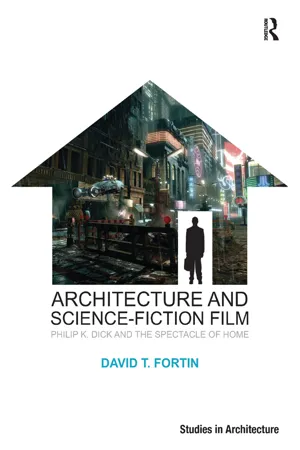
Architecture and Science-Fiction Film
Philip K. Dick and the Spectacle of Home
- 250 pages
- English
- ePUB (mobile friendly)
- Available on iOS & Android
About this book
The home is one of our most enduring human paradoxes and is brought to light tellingly in science-fiction (SF) writing and film. However, while similarities and crossovers between architecture and SF have proliferated throughout the past century, the home is often overshadowed by the spectacle of 'otherness'. The study of the familiar (home) within the alien (SF) creates a unique cultural lens through which to reflect on our current architectural condition. SF has always been linked with alienation; however, the conditions of such alienation, and hence notions of home, have evidently changed. There is often a perceived comprehension of the familiar that atrophies the inquisitive and interpretive processes commonly activated when confronting the unfamiliar. Thus, by utilizing the estranging qualities of SF to look at a concept inherently linked to its perceived opposite - the home - a unique critical analysis with particular relevance for contemporary architecture is made possible.
Frequently asked questions
- Essential is ideal for learners and professionals who enjoy exploring a wide range of subjects. Access the Essential Library with 800,000+ trusted titles and best-sellers across business, personal growth, and the humanities. Includes unlimited reading time and Standard Read Aloud voice.
- Complete: Perfect for advanced learners and researchers needing full, unrestricted access. Unlock 1.4M+ books across hundreds of subjects, including academic and specialized titles. The Complete Plan also includes advanced features like Premium Read Aloud and Research Assistant.
Please note we cannot support devices running on iOS 13 and Android 7 or earlier. Learn more about using the app.
Information
Part One
Science-Fiction, Architecture, and Home
I am far from the first to insist that science fiction ought to be read with much closer and more alert attention than it usually has been.1Carl Freedman, Critical Theory and Science-Fiction[Films] about space exploration, alien life forms, and the origin of the universe are implicitly about humanity’s quest to find our place in the time/space continuum—to feel “at home” in the universe.2Susan Mackey-Kallis,
The Hero and the Perennial Journey Home in American Film
Film, indeed, has even been seen to anticipate the built forms of architecture and the city: we have only to think of the commonplace icons of Expressionist utopias to find examples, from Das Cabinet des Dr. Caligari [1920] to Metropolis, that apparently succeeded, where architecture failed, in building the future in the present.3
Notes
1
Defining Science Fiction: Darko Suvin and the Genre

The term “science-fiction” resists easy definition.1Adam Roberts, Science Fiction: The New Cultural Idiom[One] can see how vital a role fiction has played in the development of culture. How could one not? But as John Gardner pointed out, fiction is ultimately to be grounded in our common experience of the world outside fiction if, in our cultural life and ultimately our everyday life, we are not to spiral endlessly away from reality.2Michael Benedikt, For an Architecture of RealityAn image soon stops persuading or even making any impression at all if it disconcerts us at no cost, without any element of truth.3Roger Caillois, “The Image”
Defining SF in Literature
Table of contents
- Cover
- Half Title
- Title Page
- Copyright Page
- Table of Contents
- List of Figures
- Preface
- Introduction
- Part One: Science-Fiction, Architecture, and Home
- Part Two: Re-visioning Home in Dick-Inspired Films
- Part Three: Go Home – I’m Home – Becoming Home: Architecture and Grammar in SF
- Bibliography
- Index